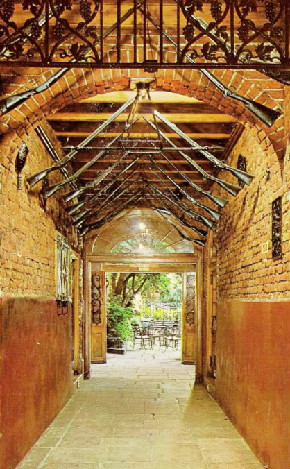
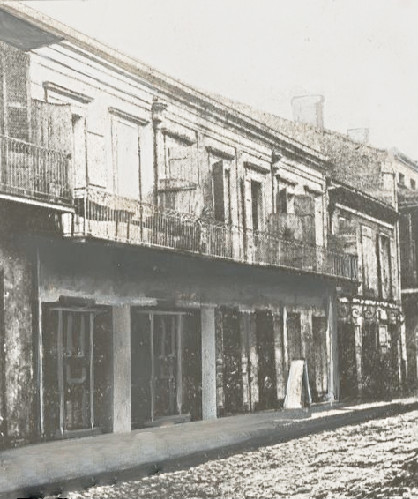
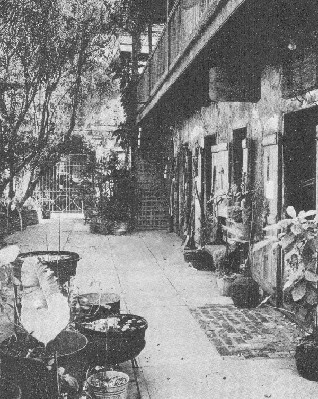
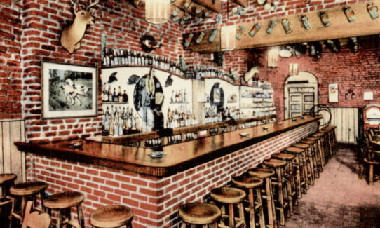
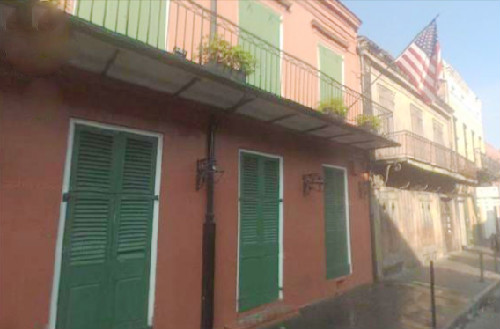
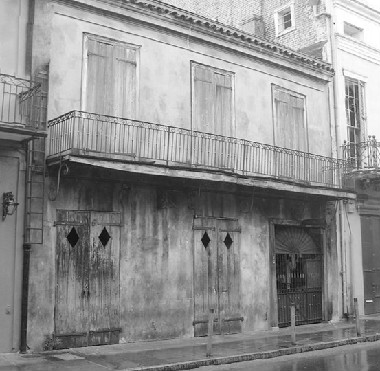
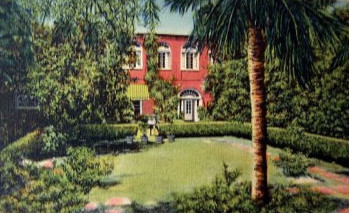
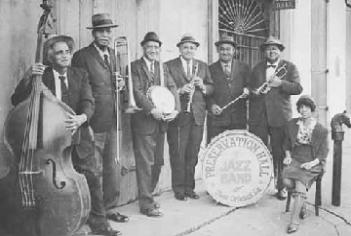
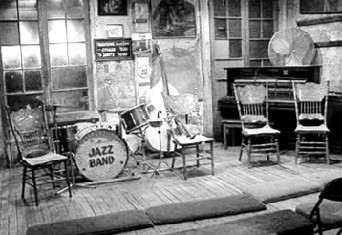
| ALL IN A ROW: Three St. Peter Street Neighbors |
| Pictured at the top of the page, a current view of three buildings in the 700 block of St. Peter Street. Directly above, the same scene, in the late 1880's. The closet building in both is 718 St. Peter. |
Three venerable buildings stand side by
side in the 700 block of St. Peter Street,
each with a long and colorful history.
Casa de Flechier/Pat O'Brien's
The building at 718 St. Peter Street was
often rumored to have been the home of
the ancient La Theatre de la rue St. Pierre,
the St. Peter Street Theater - the first
theater to be built in New Orleans. But,
according to early records, this was not
the case, the theater was actually located
on the property two doors down.
The first recorded owner of this property
was Francois Collell. In 1792, it was sold
to prominent planter, Etienne Marie de
Flechier, who constructed the building
soon after acquiring the property. The
Flechier family used it for their townhouse.
In 1817, the widow Flechier (the former
Francoise Dussan de la Croix) sold the
house to John Garnier, a planter and
brickmaker, whose kilns were located on
Poydras Street. The road to the Garnier
brickyards followed what is now
Carondelet Street and, because of the
brickyard, the road was known in those
days as Rue de la Briqueterie. The street
was later renamed for the Baron de
Carondelet (and the next street over was
named after the title of the Baron's wife,
Baronne).
Since 1942, this building has been home
to one of the top tourist attractions in the
city, famed nightspot, Pat O'Brien's.
side in the 700 block of St. Peter Street,
each with a long and colorful history.
Casa de Flechier/Pat O'Brien's
The building at 718 St. Peter Street was
often rumored to have been the home of
the ancient La Theatre de la rue St. Pierre,
the St. Peter Street Theater - the first
theater to be built in New Orleans. But,
according to early records, this was not
the case, the theater was actually located
on the property two doors down.
The first recorded owner of this property
was Francois Collell. In 1792, it was sold
to prominent planter, Etienne Marie de
Flechier, who constructed the building
soon after acquiring the property. The
Flechier family used it for their townhouse.
In 1817, the widow Flechier (the former
Francoise Dussan de la Croix) sold the
house to John Garnier, a planter and
brickmaker, whose kilns were located on
Poydras Street. The road to the Garnier
brickyards followed what is now
Carondelet Street and, because of the
brickyard, the road was known in those
days as Rue de la Briqueterie. The street
was later renamed for the Baron de
Carondelet (and the next street over was
named after the title of the Baron's wife,
Baronne).
Since 1942, this building has been home
to one of the top tourist attractions in the
city, famed nightspot, Pat O'Brien's.
| Above, courtyard at 718 St. Peter in the 1930's, when it was a private residence; right, entrance to courtyard at Pat O'Brien's, 1950's; below, a postcard featuring the interior of Pat O'Brien's in the 1940's. |
Faisendieu's Posada/Preservation Hall
Early on, the building at 726 St. Peter was the sight of the Faisendieu Posada or
tavern. In 1803, Don Antonio Faisendieu gave Don Geronimo Gros 7,200 pesos for
the property. The transfer of title states that the building sat between the home of
Don Esteban Flechier and El Coliseo or the Playhouse. This building is thought to
have been built about 1750. We know that it was standing and inhabited when the
banner of Spain waved over the old city.
An early directory shows that Antoine Fasendieu was a tavern keeper in the early
days after the Americans came into power and, in 1809, a notarial paper states that
the old inn was "united with the property of Marie de Flechier" on one side and, on
the other, with "le spectacle" (an early name for the theater). This fixes the actual
location of the St. Peter Street Theater at what is now 732 St. Peter Street.
Since 1961, the old Faisendieu Tavern has housed the world famous Preservation
Hall, a jazz hall established as a showplace for New Orleans musicians to play New
Orleans-style jazz.
Early on, the building at 726 St. Peter was the sight of the Faisendieu Posada or
tavern. In 1803, Don Antonio Faisendieu gave Don Geronimo Gros 7,200 pesos for
the property. The transfer of title states that the building sat between the home of
Don Esteban Flechier and El Coliseo or the Playhouse. This building is thought to
have been built about 1750. We know that it was standing and inhabited when the
banner of Spain waved over the old city.
An early directory shows that Antoine Fasendieu was a tavern keeper in the early
days after the Americans came into power and, in 1809, a notarial paper states that
the old inn was "united with the property of Marie de Flechier" on one side and, on
the other, with "le spectacle" (an early name for the theater). This fixes the actual
location of the St. Peter Street Theater at what is now 732 St. Peter Street.
Since 1961, the old Faisendieu Tavern has housed the world famous Preservation
Hall, a jazz hall established as a showplace for New Orleans musicians to play New
Orleans-style jazz.
| Above, Preservation Hall; above, right, the courtyard at 726 St. Peter in the 1930's. Below, left, Preservation Hall Jazz Band, early 1960's; below, right, stage of Preservation Hall. |
La Theatre de la rue St. Pierre
In 1790, Louis Chevalier de Macarty purchased the property at 732 St. Peter Street at
public auction from Juan Doreto del Postigo. A year later, Don Luis Alessandro
Henrique secured two pieces of property, one from Chevalier Macarty and the other
from Geronimo Gros, both of which were described as lying between the property of
Pedro Lambert (who owned the Bourbon Street corner site) and Francois Collell (who
later sold his property to Don Esteban de Flechier).
In 1791, a troop of strolling actors landed in New Orleans from Santo Domingo and
started giving performances at the site of the current-day 732 St. Peter. It was then
that the title of El Coliseo was given to the building located there at the time.
Performances continued until El Coliseo was closed by the authorities, due to "a
noisy and boisterous element who frequent the playhouse, along with the elite.". In
1804, police had issued a notice warning that "troublemakers" would be prosecuted
and outlining a long list of do's and don'ts for visitors to the theater.
After 1793, the playhouse went by the name of La Salle de Comedie for several years.
Performances continued off and on for a number of years after New Orleans became
an American city, under the name of La Theatre de la rue St. Pierre.
In 1821, the property where the theater had been located was sold by Gen. J. B.
Labatut and it's believed that the new owners erected the present building on the
foundations of the old playhouse at that time.
Currently, the building is home to Ali Baba, a popular Greek restaurant.
In 1790, Louis Chevalier de Macarty purchased the property at 732 St. Peter Street at
public auction from Juan Doreto del Postigo. A year later, Don Luis Alessandro
Henrique secured two pieces of property, one from Chevalier Macarty and the other
from Geronimo Gros, both of which were described as lying between the property of
Pedro Lambert (who owned the Bourbon Street corner site) and Francois Collell (who
later sold his property to Don Esteban de Flechier).
In 1791, a troop of strolling actors landed in New Orleans from Santo Domingo and
started giving performances at the site of the current-day 732 St. Peter. It was then
that the title of El Coliseo was given to the building located there at the time.
Performances continued until El Coliseo was closed by the authorities, due to "a
noisy and boisterous element who frequent the playhouse, along with the elite.". In
1804, police had issued a notice warning that "troublemakers" would be prosecuted
and outlining a long list of do's and don'ts for visitors to the theater.
After 1793, the playhouse went by the name of La Salle de Comedie for several years.
Performances continued off and on for a number of years after New Orleans became
an American city, under the name of La Theatre de la rue St. Pierre.
In 1821, the property where the theater had been located was sold by Gen. J. B.
Labatut and it's believed that the new owners erected the present building on the
foundations of the old playhouse at that time.
Currently, the building is home to Ali Baba, a popular Greek restaurant.
| Much of the information on this page came from a first edition of Stanley Clisby Arthur's "Old New Orleans," published in 1936. The link to this page is: http://old-new-orleans.com/NO_Neighbors.html Back to Old New Orleans Whispers - Home |